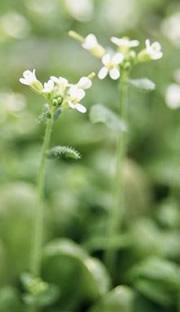 Arabidopsis plants usually fertilize themselves, but cross-pollination is possible.Punchstock
Arabidopsis plants usually fertilize themselves, but cross-pollination is possible.PunchstockOne of last year's most stunning biological discoveries is being called into question. Researchers say they are unable to repeat experiments that were thought to reveal a form of inheritance previously believed impossible.
In their 2005 Nature1 paper, Bob Pruitt and his colleagues at Purdue University in West Lafayette, Indiana, challenged the textbook rule stating that offspring receive a mix-and-match of their parents' genes. They suggested that some plants can instead convert their genetic sequences back into the code possessed by their grandparents or earlier generations — a discovery that sent ripples through the genetics community and beyond.
Now Steve Jacobsen of the University of California, Los Angeles, and his colleagues say they cannot replicate Pruitt's work in their own experiments. In a short paper published online in Nature2, they say stray pollen could account for Pruitt's results instead.
Since Pruitt's paper came out last year, other work, including experiments with mice, has supported this idea of an alternative mechanism of inheritance (see 'Mutant mice challenge rules of genetic inheritance'). The new paper does not cast this other work into doubt.
Hot heads
Pruitt studied a strain of the cress plant Arabidopsis that carries a mutation in both copies of the HOTHEAD gene. According to standard genetics, the offspring of these plants will inherit the mutated gene. But Pruitt's team found that many of the next generation carried one or two normal copies of the HOTHEAD gene instead: they appeared to have reverted to the gene sequence of their ancestors.
One of the explanations they proposed for this is that eggs or pollen, which combine during fertilisation, carry a 'backup' store of genetic information from one generation to the next in the form of RNA, the close cousin of DNA. This could be used to correct mutant DNA under certain conditions, such as drought or other stress.
When Jacobsen and his colleagues attempted to repeat the experiment, however, they found that the offspring of plants that reverted their HOTHEAD gene back to normal also contained other telltale genes that could only have come from the pollen of plants growing nearby.
Jacobsen says the simplest explanation is that plants with a mutant version of the HOTHEAD gene were contaminated with normal pollen. When his team grew mutant plants in total isolation from any other Arabididopsis plants, they found that the mutant genes no longer reverted to the normal form.
Arabidopsis is normally self-fertilized, with one and the same plant producing both the egg and the pollen that fertilizes it. The HOTHEAD mutation leads to oddly shaped flowers, however, and Jacobsen suggests that these might increase their plant's chance of being fertilized by pollen from another plant.
Solitary confinement
In the experiments reported in his Nature paper, Pruitt did not grow the plants in complete isolation from other Arabidopsis, as Jacobsen did. But Pruitt says that the possibility of pollen contamination occurred to his team early on and that it cannot explain all of the results.
For example, some of the offspring plants in Pruitt's experiments carried two copies of the normal HOTHEAD gene. Stray pollen might contribute one of these copies, but it cannot explain the change in the second copy of the gene, which comes from the egg. Pruitt and his colleagues have written a response to Jacobsen in Nature3.
ADVERTISEMENT
It is possible that differences in soil, water or other growth conditions might explain the different results, Pruitt suggests. Both scientists agree that the best way to resolve the discrepancy is for independent laboratories to grow the plants in isolation.
Pruitt says that it is also important to find a plausible biological mechanism by which the plants could be correcting their DNA - concrete evidence for the inherited store of RNA, for example. "Until we have a solid handle on the mechanism, it's all just talk," he says.
"Anytime there's something sensational, scientists will say there's got to be something wrong with it," says plant geneticist Vicki Chandler at the University of Arizona, Tucson, who says she received about 50 e-mails from fascinated colleagues when the Pruitt paper was published. "I hope not," she adds. "It's pretty intriguing and it was careful science".
Visit our geneticfinding_called.html">newsblog to read and post comments about this story.
